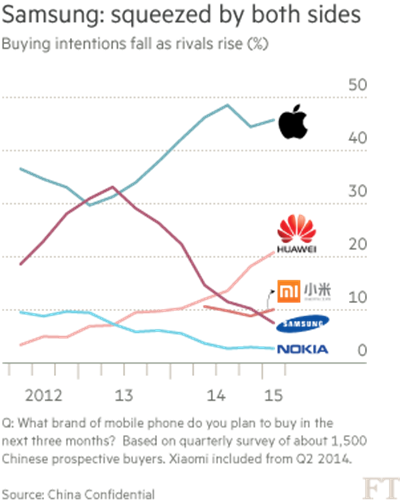(单词翻译:单击)
What a difference two years makes. Back in 2013, Samsung was riding high in China’s smartphone market. According to data from China Confidential, a research service from the Financial Times, a third of prospective smartphone buyers (out of 1,500 surveyed by China Confidential in Q2 2013) planned to purchase a Samsung device, ahead of Apple and other domestic and multinational competitors.
两年的变化真大!回首2013年,三星(Samsung)还在傲然驰骋中国智能手机市场。根据英国《金融时报》研究服务机构《中国投资参考》(China Confidential)的数据,当时三分之一的潜在智能手机购买者(《中国投资参考》在2013年第二季度针对1500人进行了调查)计划购买三星手机,领先于苹果(Apple)以及其他中国国内和跨国竞争对手。
Since then, however, the Korean handset maker’s popularity has suffered a dramatic decline, as it has found itself squeezed from above and below. Its popularity more than halved between Q2 2013 and Q2 2014, and has halved again since, with just 7.4 per cent of prospective buyers in China Confidential’s most recent survey planning to buy a Samsung phone.
然而,此后,这家韩国手机制造商的受欢迎程度大幅下滑,该公司发现自己腹背受敌。2013年第二季度至2014年第二季度,三星受欢迎程度下降逾一半,此后再次下降一半,在《中国投资参考》的最新调查中,只有7.4%的中国潜在手机购买者计划购买三星手机。

Apple’s popularity, by contrast, has surged over the same period, buoyed first by the launch of lower-priced iPhone models and more recently by the release of the large-screen iPhone6 and 6 Plus models last October — the large screen-size of many Samsung models had been a major reason for their previous popularity in China. Ahead of the iPhone 6 launch, a record 48.5 per cent of phone buyers said they planned to buy an Apple phone in China Confidential’s Q3 2014 survey. While Apple buying intentions moderated slightly in the immediate aftermath of the launch, they have remained strong, with Chinese buyers continuing to be attracted by Apple’s strong brand and the good reputation of its handsets.
相比之下,苹果的受欢迎程度同期一直飙升,首先得益于价格较低iPhone机型的推出,而后又受益于去年10月iPhone 6和iPhone 6 Plus大屏手机系列的推出——很多三星手机配备的大屏幕一直是三星之前在中国广受欢迎的一个主要原因。在《中国投资参考》2014年第三季度的调查中,在iPhone 6推出之前,创纪录的48.5%的手机购买者表示,计划购买苹果手机。尽管在iPhone 6推出后不久,消费者购买苹果手机的愿望略有下滑,但苹果手机的需求仍一直强劲,中国消费者继续被苹果的强大品牌以及手机质量的良好声誉所吸引。
This has driven stellar China sales growth for the US company, with China iPhone sales soaring 72 per cent year on year during the first quarter of 2015, outstripping sales of the handset in the US for the first time. Strong buying intentions for Apple in China Confidential’s most recent survey suggest that this strong sales picture likely persisted into Q2 2015. By contrast, the fact that Samsung buying intentions continued to fall in despite the imminent launch of its heavily promoted Galaxy S6 and S6 Edge models does not bode well; the contrast with the surge in buying intentions ahead of Apple’s iPhone 6 launch was marked.
这推动苹果在华销量强劲增长,2015年第一季度,iPhone在华销量同比飙升72%,首次超过在美国的销量。在《中国投资参考》最新调查中,对苹果手机的强劲购买意愿表明,这种强劲销量趋势可能会持续到今年第二季度。相比之下,尽管三星即将推出其大力宣传的Galaxy S6和Galaxy S6 Edge系列,但消费者购买三星手机的兴趣继续降温,这不是个好兆头;这与在苹果推出iPhone 6之前消费者购买iPhone兴趣飙升形成鲜明对比。
Meanwhile, at the lower end, Samsung has found itself increasingly outplayed by lower-cost Chinese smartphone makers such as Huawei and Xiaomi, both of which make and sell feature-rich handsets using the same Android operating system as Samsung phones but at significantly lower prices. The cheapest model in Samsung’s popular Galaxy series retails in China for around Rmb2,000 ($322), whereas both Xiaomi and Huawei sell smartphone handsets for about half this price. In China Confidential’s most recent survey, 20.8 per cent of respondents said they planned to buy a Huawei phone, up more than 100 per cent year on year, while 10.1 per cent planned to buy a Xiaomi handset, ranking it ahead of Samsung for the first time in the survey.
与此同时,在较低端智能手机领域,三星发现自己正日益被华为(Huawei)和小米(Xiaomi)等中国成本较低的手机制造商赶超,华为和小米生产和销售功能丰富的智能手机,都采用与三星手机一样的安卓(Android)操作系统,但价格却低得多。在颇受欢迎的三星Galaxy系列手机中,价格最低的机型在中国的零售价在2000元人民币(合322美元)左右,而小米和华为销售的智能手机价格为三星价格的一半左右。在《中国投资参考》的最新调查中,20.8%的受访者表示,他们计划购买华为手机,同比增加逾一倍,10.1%的受访者计划购买小米手机,这是《中国投资参考》开始此项调查以来小米排名首次超过三星。
Samsung is taking measures to address this slide in its popularity, including the development of its own operating system and new product launches. Yet it faces an uphill task to win back lost market share in China, especially as smartphone sales begin to slow as the market matures.
三星正采取措施应对人气下滑局面,包括开发自己的操作系统以及推出新产品。然而,该公司面临着夺回在中国丧失的市场份额的艰巨任务,特别是随着市场的成熟,智能手机销量开始放缓。
Apple remains overwhelmingly the smartphone brand of choice among high-end consumers and is aiming to expand its appeal among lower-income consumers and those in lower-tier cities, where Samsung has previously enjoyed stronger popularity than its US rival.
苹果仍然是高端消费者智能手机品牌的不二选择,苹果还计划增强其在较低收入人群以及二三线城市消费者中的吸引力,在这部分人群,三星以前的受欢迎程度要超过苹果。
Meanwhile Huawei and Xiaomi, and emerging challengers such as Oppo and Meizu, in which Alibaba purchased a minority stake in February, continue to release new handsets and are investing heavily in research and development and marketing.
与此同时,华为和小米,以及Oppo和魅族(Meizu)等新兴竞争对手,正继续发布新款手机,并在研发和市场营销方面投入巨资。今年2月,阿里巴巴(Alibaba)购入魅族少数股权。
The really bad news for Samsung is that these struggles are not confined to China. Chinese handset makers such as Xiaomi and Oppo are increasingly broadening their focus beyond the home market — in particular into India and Southeast Asia, where their low-cost, feature-rich handsets have already won them significant popularity in a short time. Samsung’s reversal of fortunes in China could well play out in other regional markets.
对于三星而言,真正糟糕的消息是,这种困境并不限于中国。小米和Oppo等中国手机制造商正日益扩大其对本国市场之外领域的关注,特别是进军印度和东南亚市场,其低成本且功能丰富的手机已在短时间内让它们受到极大欢迎。三星在中国命运的逆转很有可能会在其他亚洲市场重演。


